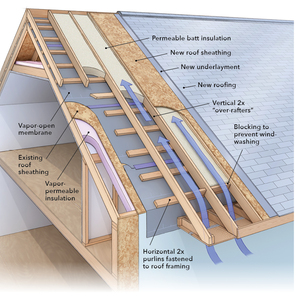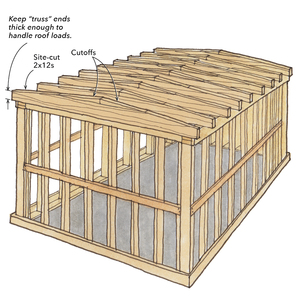Q:
I recently had the underside of my roof deck insulated with closed-cell polyurethane foam. In order to meet code here in northern Canada, the crew needed to install 4 in. of foam to get to the required insulating value. This much foam fully encapsulated the 2×4 top chords of each roof truss. I’m worried that these 2x4s are going to rot because they cannot breathe. Is it problematic to encapsulate wooden framing components in foam?
Mark Helmrich, None
A:
Engineer Joe Lstiburek, principal at Building Science Corp. in Westford, Mass., replies: It is not a problem to fully encapsulate framing members with high-density closed cell foam, regardless of your climate. Note that the wood roof deck itself is, more or less, fully sealed with foam, yet there is still some downward drying into the attic and upward drying through the shingles and roof underlayment, even in a severely cold place where they play hockey outside in June. It’s true that the thicker the layer of foam, the lower the potential for inward drying, but that thicker foam also means there’s a lower potential for upward wetting, so it’s less likely to see moisture in the first place. Likewise, a thinner layer of foam, such as what you have covering the edges of your truss chords, has a greater potential for upward wetting, but there’s also a higher potential for inward drying. Simply put, the thickness of the foam layer over the framing members does not matter much one way or the other.
Fine Homebuilding Recommended Products
Fine Homebuilding receives a commission for items purchased through links on this site, including Amazon Associates and other affiliate advertising programs.

Caulking Gun

Peel & Stick Underlayment

Utility Knife

























